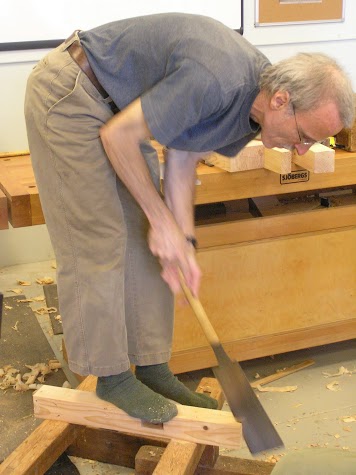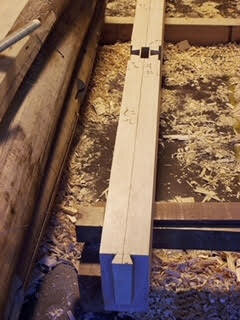Japanese Joinery
6 Days, Some Skills Required
Fall 2023
November 27-December 2
This six-day course will offer details of the fundamentals of Japanese woodworking. In this class we will put to use the tools that were set up in the beginner class (Japanese Tools), taking the next step in understanding what to do with them. The focus will be on design, layout, and cutting of the joints used in constructing traditional buildings.
There will be a wealth of information presented that has until now been only sparsely available here in the States. Please bring your tools sharpened and ready to work. If time allows we will discuss application of these techniques to your own pet project. Hope to see you there!
We'll start this six-day course with reviewing and delving deeper into material selection covering the qualities of various wood species and grain types. We’ll move into stock preparation, straightening and squaring our material by hand. Next, we’ll review types of joints and their application, then begin layout using the Japanese carpenters square. Those who wish to set up a sumitsubo and sumisashi are welcome to bring them along. We'll cut out the joints with hand tools and practice finish planing, further refining our shavings and techniques. Starting with various types of mortise and tenon joints, we'll progress to dovetails, then on to splice joints of various complexity.
These joints along with the woodworking methods and techniques used to cut them have historically been broadly applied to all types of woodworking in Japan; from grand temples to residences including interior woodwork, plus all the fixtures such as doors and traditional furniture like low tables and chests (tansu). The learning is hands-on, step-by-step instruction, in this impressive tradition.
This class is intended to provide a foundation of the basics in woodworking and will be a prerequisite for future construction classes.
Required Tools
Chisels
18 mm(3/4’’) and 12mm (1/2") are required but bring other various sizes, including slick chisels, if you have them; 48 mm (1 7/8”) will be very helpful. Any brand of chisel will work; of course Japanese would be best.
Hand planes
At least one Japanese smoothing plane and one Japanese scraper plane (tachiganna). Also associated tools for conditioning the block such as a beveled straight edge.
Saws
One medium 270mm Ryoba (double-edged) saw: Also a small saw 210mm~240mm crosscut or ryoba for tenon shoulders or a crosscut Dozuki (Japanese Backsaw) will be useful.
Sharpening Stones
Japanese water stones required: one medium (1000~1200 grit) and one finish stone (minimum 4000 grit). Bring other stones that you commonly use such as a course stone (220~600 grit) and any intermediate stones. Stone flattening tools such as a kanaban and sandpaper, bucket for water, etc.
Hammers
One medium size 375~550g for mortising work. Other size hammers can be useful too.
Layout tools
One flexible full-size Japanese carpenter's square. It can have inch or shyaku measurements. We will not be using metric scale. A machinist's square or a try-square could also be useful. For marking, bring good quality pencils (Mitsubishi Hi-uni is best) or a Japanese bamboo brush (sumi-sashi) with ink pot (sumi-tsubo). Note: if you are purchasing a new sumitsubo, be sure to get silk and string. Raw silk purchased from a yarn supply rather than tool stores will be much higher quality. In addition, a marking gauge can be useful.
If you are driving and have room, please bring any other hand tools that you would normally use for woodworking (No power tools).
Here is a link to the Japanese Carpentry Class Tool List that you can print.
Prerequisites
Some skills required. Completion of the basic Japanese tool class immediately preceding this or one of Dale's previous classes is required. If you are unsure that your previous class experience qualifies you for this one, please contact the school or Dale.
Class Information and Registration
Class runs 9:00 am to 5:00 pm Monday through Saturday in Building 304 at Fort Worden. Map
Please read our What to Expect page for general information about the School.
Please also read our Registration Policy.
If the course is full, please sign up for the waitlist.
Class size: 12
Cost: $1,020
Materials Charge: $50






Japanese Carpentry
Seattle, WA